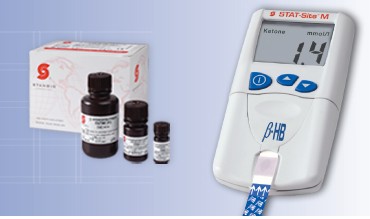The EKF Stanbio Liqui Color® Beta-Hydroxybutyate chemistry reagents is an enzymatic assay used by many of the most respected healthcare systems.B-Hydroxybutyate (B-HB) is run on an open channel of a laboratory ananlyser.The reagent can quantifiably detect the presence of ketones in patients with suspected diabetic ketoacidosis.
In addition, B-HB can be used to clinically diagnose and monitor the disease status or severity of alcoholism, glycogen storage disease, high fat/low carbohydrate diets, pregnancy, alkalosis, ingestion of isopropyl alcohol, and salicylate poisoning.
WHATS IS KETOSIS?
When the body begins to break down its stored fats in response to a low supply of energy (glucose) it produces the ketone ß-Hydroxybutyrate, which is further catabolised into acetoacetate and then into acetone.
Ketones (like glucose) can be tested or monitored in either urine or blood. Many hospitals still use Acetest or Ketostix for detecting and monitoring ketosis and ketoacidosis. This nitroprusside urine method produces a qualitative assessment of ketosis and ketoacidosis by detecting both acetoacetate and acetone. However nitroprusside methods do not detect B-HB.
B-HB is a better test for ketosis and ketoacidosis than nitroprusside methods for a number of reasons:
- The nitroprusside method detects less than 22% of the ketones present in ketosis. B-HB is the main ketone produced by the body (78%).
- B-HB demonstrates excellent stability, making it the most reliable indicator of clinically relevant ketosis and ketoacidosis.
- During ketosis, B-HB levels increase more than levels of acetone and acetoacetate, clearly indicating the patient's trend in metabolic status.
- Quantitative, objective Beta-Hydroxybutyrate results provide a better tool for differentiating metabolic acidosis and monitoring therapy.
DIABETIC KETOACIDOSIS
People with type 1 diabetes may be at risk when they do not have enough insulin, a hormone the body uses to break down sugar (glucose) in the blood for energy. When the body senses glucose is not available, fat is broken down instead.
As fats are broken down, acids called ketones build up in the blood and urine. Ketones are poisonous in high levels. This condition is called ketoacidosis.
Blood glucose levels rise (usually higher than 300 mg/dL) because the liver makes glucose to try to combat the problem. However the cells cannot pull in that glucose without insulin.
Symptoms can include rapid deep breathing, dry skin and mouth, flushed face, fruity smelling breath, nausea, vomiting and stomach pain. Other symptoms that can occur are; Abdominal pain, breathing difficulty while lying down, decreased appetite, decreased conciousness, muscle stifness and aches, dulled senses that may worsen to a coma and frequent urination and thirst that lasts throughout the day.

FIND OUT MORE
To find out more about how B-HB can improve diagnosis in your laboratory using the EKF Stanbio LiquiColor Beta-Hydroxybutyrate chemistry reagent CONTACT EKF DIAGNOSTICS today.
Click on the tabs on the right of this page to view a video from Dr James Nichols, (formerly of Tufts University, Boston) Now Professor of Pathology, Microbiology & Immunology and Director of Clinical Chemistry at Vanderbilt University School of Medicine, Nashville, TN.
STAT-SITE M B-HB
The STAT-Site M β-HB system is intended for the quantitative determination of β-Hydroxybutyrate
in serum or plasma,aiding in the diagnostics and monitoring of ketoacidosis.It is composed of
a reflectance photometer and dry-reagents test strips.
- Quantitative ß-HB results provide the best and earliest indicator of ketosis and resolution of ketoacidosis (DKA).
- Reliable: ß-Hydroxybutyrate is 78% of all available ketones and provide a better tool for differentiating metabolic acidosis and monitoring response to therapy.
- Improved Clinical Outcomes: resulting in higher quality of patient care while reducing ER/ICU patient stay.
- Fast: new platform delivers results within 80 seconds.
- No lag time due to testing Serum or Plasma samples.
Specifications:
Methodology: Reflectance photometry
Principle: ß-Hydroxybutyrate dehydrogenase
Sample Size: 10µL
Range: 0.0 - 2.0 mmol/L (without dilution)
Calibration: Automatic (CODE Key)
Lot specific CODE Key included in every box of test strips.
To find out more about the STAT-Site Beta-Hydroxybutyrate photometer MAKE AN ENQUIRY NOW >
Or look at out entire range of Clinical Chemistry reagents.
bio-equip.cn





